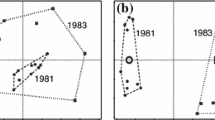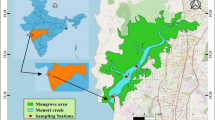Abstract
Data transformation is seen here as an aspect of scaling such that we are less interested in the quirks and properties of each transformation but are more concerned with the general scaling properties and trends of suites of transformations.
Over two years of daily phytoplankton abundance data for 30 species from a temperate lake (Llyn Maelog, North Wales) were subjected to a series of scale-ordered transformations. Two major classes of transformation were systematically varied: binary and smoothing. Binary transformation scaled the cutoff threshold between ‘presence’ and ‘absence’ of a species to various levels of abundance.
With successively smaller universes and smoothing windows and successive species exclusion, ordinations of sample dates revealed smaller scaled structures in the order: annual cycles of species turnover, seasonal areas of attraction and uniqueness of individual sample dates. Gradual increases in the length of the smoothing window resulted in gradual shifts in the positions of points in sample data ordination, but not necessarily in the species ordinations. Thus sample data structures are more stable with change in scale than are species data structures. These differences in stability are discussed in the context of filtering characteristics of data collection and data analysis. Transformations producing similar species statistics (means, variances and skews) did not generally give similar ordination results, while some transformations giving similar ordinations differed in species statistical parameters.
Similar content being viewed by others
References
Allen, T. F. H., Bartell, S. M. & Koonce, J. F., 1977. Multiple stable configurations in ordination of phytoplankton community change rates. Ecology 58: 1076–1084.
Allen, T. F. H. & Koonce, J. F., 1973. Multivariate approaches to algal stratagems and tactics in systems analysis of phytoplankton. Ecology 54: 1234–1246.
Allen, T. F. H. & Shugart, H. H., 1983. Ordination of simulated complex forest succession: a new test of ordination methods. Vegetatio 51: 141–156.
Allen, T. F. H. & Skagen, S., 1973. Multivariate geometry as an approach to algal community analysis. Br. Phycol. J. 8: 267–87.
Allen, T. F. H. & Starr, T. B., 1982. Hierarchy: Perspectives for Ecological Complexity. Univ. Chicago Press, Chicago.
Austin, M. F., 1976. On non-linear species response models in ordination. Vegetatio 33: 33–41.
Austin, M. P. & Greig-Smith, P., 1968. The application of quantitative methods to vegetation survey. II. Some methodological problems of data from rain forest. J. Ecol. 56: 827–844.
Austin, M. P. & Orlóci, L., 1966. Geometric models in ecology: In. An evaluation of some ordination techniques. J. Ecol. 54: 217–222.
Bartell, S. M., Allen, T. F. H. & Koonce, J. F., 1978. An assessment of PCA for description of phytoplankton periodicity in Lake Wingra. Phycologia 17: 1–11.
Beals, E. W., 1973. Ordination: mathematical elegance and ecological naiveté. J. Ecol. 61: 23–35.
Beals, E. W., 1983. Bray-Curtis Ordination: an effective strategy for analysis of multivariate ecological data. Adv. Ecol. Res. 13: (in press).
Campbell, B. M., 1978. Similarity coefficients for classifying relevés. Vegetatio 37: 101–9.
Chardy, P., Glemarec, M. & Laurec, A., 1976. Application of inertia methods to benthic marine ecology: practical implications of the basic options. Estuarine Coastal Mar. Sci. 4: 179–205.
Gauch, H. C. & Whittaker, R. H., 1972. Comparison of ordination techniques. Ecology 53: 868–875.
Gauch, H. G.Jr., Whittaker, R. H. & Wentworth, T. R., 1977. A comparative study of reciprocal averaging and other ordination techniques. J. Ecol. 65: 157–174.
Hill, M. O., 1973. Reciprocal averaging: an eigenvector method of ordination. J. Ecol. 61: 237–49.
Hill, M. O. & Gauch, H. G.Jr., 1980. Detrended correspondence analysis: an improved ordination technique. Vegetatio 42: 47–58.
Jensen, S., 1978. Influences of transformation of cover values on classification and ordination of lake vegetation. Vegetatio 37: 19–31.
Kessel, S. R. & Whittaker, R. H., 1976. Comparisons of three ordination techniques. Vegetatio 32: 21–29.
Lambert, J. M. & Williams, W. T., 1961. Multivariate methods in plant ecology. IV. Nodal analysis. J. Ecol. 50: 775–802.
Maarel, E.van der, 1979. Transformation of cover-abundance values in phytosociology and its effects on community similarity. Vegetatio 39: 97–114.
Noy-Meir, I., 1973. Data transformations in ecological ordination. I: Some advantages of non-centering. J. Ecol. 61: 329–42.
Noy-Meir, I., Walker, D. & Willams, W. T., 1975. Data transformations in ecological ordination II. On the meaning of data standardization. J. Ecol. 63: 779–800.
Rosen, R., 1977. Observation and biological systems. Bull. Math. Biol. 39: 663–78.
Simon, H., 1962. The architecture of complexity. Proc. Am. Philos. Soc. 106: 467–482.
Smart, P. F. M., Meacock, S. E. & Lambert, J. M., 1976. Investigations into the properties of quantitative vegetational data. II. Further data type comparisons. J. Ecol. 64: 41–78.
Woodhead, N., 1937. Studies in the flora of Anglesey and Caernarvonshire lakes. North Western Natur. 12: 160–171.
Author information
Authors and Affiliations
Additional information
Acknowledgement: The present research was supported by a grant from the National Science foundation (NSF DEB 78-07546) to the first author.
Rights and permissions
About this article
Cite this article
Allen, T.F.H., Sadowsky, D.A. & Woodhead, N. Data transformation as a scaling operation in ordination of plankton. Vegetatio 56, 147–160 (1984). https://doi.org/10.1007/BF00045222
Accepted:
Issue Date:
DOI: https://doi.org/10.1007/BF00045222




